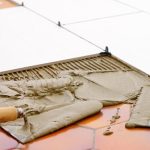Substructure is very important for ceramic floor implementation. Leveling, tilting and adhesion of mortar play an important role in ceramic work. In the following, we will talk about the types of ceramic work methods. Ceramic floor installation is done in four ways: 1- Mortar method for ceramic installation. This method is one of the oldest ceramic work methods. In this method, sand, cement and water are combined to obtain a paste mortar. At the same time as mortar is spread, ceramics are also applied. Of course, before starting the work, chrome plating is done so that the slope is executed correctly.
2- Mortar and grout method (combined) In this method, the surface is first filled with 3 cm thick cement-sand mortar. Then it is executed with a flat surface or a sloped surface with a leveler. With the passage of time and the hardening of the mortar, white cement slurry is poured on the surface and the ceramic is installed.
3- Glue method for ceramic installation. This method is like using mortar and grout, with the difference that glue is used instead of grout. In the method of ceramic work with glue, in most cases, the surface is mosaiced first, and then the ceramic is applied with glue.
4- The dry method (chassis drawing) is used for the installation of ceramics because the method of mortar and grout cannot be used on the facade. Ceramics are connected to the chassis in a dry form by hidden or visible clips. This method is safe and resistant to earthquakes and weather conditions.







